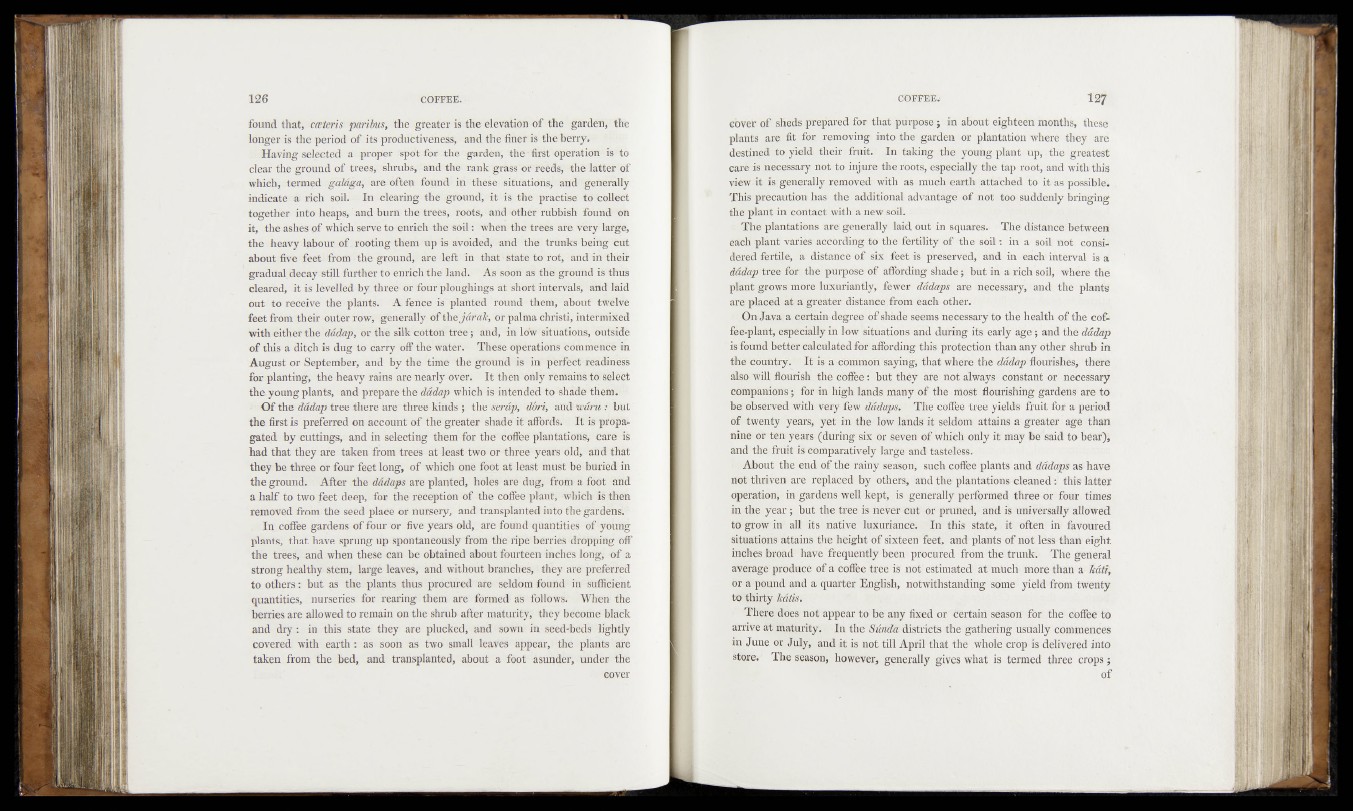
found that, coeteris paribus, the greater is the elevation1 of the garden, the
longer is fche'period of its productiveness, 'and; the finëp'iâ the berry,
g Having selected a proper :spdt-fbtó^fche garden; thé-first-operation is Ho
clear the ground of trees,, shrubs, and the sank 'grass of‘réeds>L thedatter of
which, termed galâga, are-often found ip these situations, and-'-genérally
indicate a rich soil.. - In clearing-the ’ground, it -is; the'practise to Collect
together into heaps, and burn the-treès, roots, and other rubbish found-to
it, the ashes of which serve toenrich the soil:-when the'trees are very-large,
the heavy labour _o£L rooting them Up ft avoided, and the trunks being ;(6ut
about five feet-from-the ground, -are left in that1 state to- tot, - and in their
gradual decay still further to enrich the-land-. As soon as the ground is thus
cleared, it is levelled- by three 'or foùrplûughirigs at short- ‘intervals, ’ and laid
out to receive-the plants. -A fence-is planted ' round-‘fteS^bfeoufl twelvè
feet from,their outer row, generally of thejârak, or palma christi, intermixed
with-either the dâdap, or-the silk'cêttön-trée ; and, in ld^rituMohS/oiifeide
of this a ditçh is dug to carry off the water.1 These operations 'Commencé m
August or- September, and by the time' thé. greb®« is ■ in' p'erffect-’readinbss
for planting, the-heavy rains are nearly-over. It then-only1 'remains tds’êlèct
the. young plants, and prepare the dâdap which' is intended to shade':tKeïr&i!d
3 Of the dâdap treâÀere are three kinds iflllfe Sèrâp'i and ‘wârii i ‘but
the first is preferred on account of the greater shade ifaffordsi If%propa-
gated by cuttings,- and in selecting them for théhedffee plantations?1 care ft
had that they are taken from trees at least two or- -three" years old, and that
they be three or four feet long, of which one fact at least ratof-hfeiMiri'éd-in
the ground. : After the dâdaps are planted, holes are- dug, from a foflt -and
a.half to two feet'dëéppdbi? the reception of the coffee plant, -wMèh- is1 then
removed f rom the seed placé ôr nursery, and transplanted into the-gardehsi, 1
| Incoffee gardens of fourorfive years old, are found quantities of-young
plants, that haW sprang up spontaneously from the ripe1 berries -dropping off
the trees, and when these can be obtained about fourteen inches long, &f a
strong healthy, stem, large leaves, and without branches, ' thfey aré preferred
to others : hut as thé plants thus procured ate seldom-fouiid in suifiëxfent
quantities,- nurseries for rearing • them are- formed- as follows. When- the
berries are: allowed to remain on the shrub after maturity,- they becomeblack
and dry : in this state they are plucked, and sown in. seed-beds lightly
covered, with earth : as soon as two small leaves appear, the plants are
taken from the bed, and transplanted, about a foot asunder, under the
cover
cbveh o f steeds prepared; fbu thgife purpose:; in about eighteen months, these
plaàM are fitetffïb, .removing, iktorffre' garden or plantation where they1 are
destined to)yield- their fruit.’ Jim taking the^ybuteg-pl'ant up, the greatest
caré is .necessary nofitp injure the,foots, espemal’ly the1 tap root, and witbthil
viewflt i:s;géner-ally rèmoVedPwit-h as -mflCji dearth: attached to it1 as possible!
This precaution has the additional advantage of not too-suddenly bringing
the plant iiï contact with, a new sdill -
The plantations am generally laid eût in squares’.- The- distance-between
each plant varies aecôrüïngi-tp -thte'jfeftility of the soil- : in a Soil' i®>t const)
dered fè-t&lé; a distapeh- bf&ffe* feet ft- preserved, and1 in éàch interval is a
dâdap tree for^thè'pnrpose of affording shade ; but in a rich soil, where the
pliant growsrmore luxuriantly, fewer - dâdaps are ■Heeessary,-Ian(I the plant's
aréHÿfei®îSflyM<â: -giiiitMîVidlsianêés ^om1 each other. '
- ,OnJJava a certain-degree-oftshstde'seems necessary to the'health of the coft
fee-plant, especially in low situations-and during its early age ; and the dâdap
is found better calculated f0r-! affording this- protection than any other shrub in
fhCJcoufttry'.- It is- a common saying; that where the dâdap flourishes, there
Mso'-wrll- flourish thè ébffee-: but théy are not always constant or necessary
companions ; for in highlands many of the most flourishing gardens are to
be observed withvéïyféW dâdaps. The coffee tree yields- fruit for a period
of' twenty years, yètrin the low lands it seldom- attains a greater age than
ïlinéto tCnfyeafs- (during si&to -sfeverFof which only it- may be said to bear);
and th"éJ fruit is comparatively large and' tasteless. '
About the end- of the rainy season; such coffee plants and- dâdaps as have
not-'thriven arfe replaced1 by'-others, and the plantations cleaned: thft lattef
operation; in gardens well -kept, is generally performed three or four times
in fHmye'ar ; but thetree is never cut to pruned-, and il^értV&sïffly àlewed
to grow in; all its-' native luiuriahee. In this- staté,-. it- oftèk: in- ftVoüled
situations attains the height of sixteen feet, and plants of nof-léss than eight
inches broad have frequently been procured-from the trunk. The general
average produce of a coffee tree is not estimated at müch- iiibre than a Jcâtt,
or à-ipound and a quarter English, notwithstanding some yield'-from twenty
td thirty îeâtis.
' There does not' appear to be any fixed or êertain season for the c'offëé to
arrive a t maturity. In the Sândà districts the gathering usually commences
in, Juliew July, and it is not till April-that the whole crop'is delivered into
store.' The season, however, generally gives what is termed three crops $
of